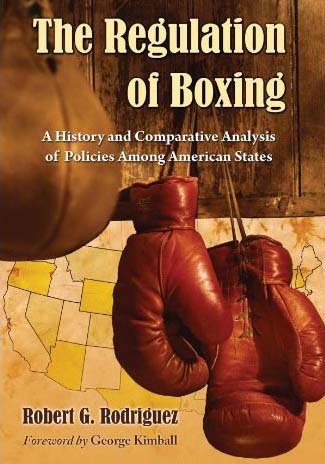BOOK REVIEW
Tracy Callis
THE REGULATION OF BOXING
A History and Comparative Analysis of Policies Among American States
By
Robert G. Rodriguez
This book is a scholarly work that takes an in-depth look at the ways in which various states govern the boxing contests held within their boundaries. It is interesting and informative and imparts a true education to the reader regarding just how different the regulating bodies are. How the states do this is important because there is no national boxing commission in the United States to oversee the sport.
Dr. Rodriguez blends together the various aspects of fight history - social concerns, health and safety issues, particular bouts and moments in boxing, the development of rules, regulations and other innovations to make the sport fair and safe. Along the way, such things as ring size, the use of gloves, establishment of weight classes and the sporting clubs that sponsored (and, thereby, allowed) boxing are talked about.
The following description appears on the Amazon and McFarland websites --
This first nationwide study of boxing regulations in the United States offers an historical overview of the subject, from the earliest attempts at regulating the sport to present-day legislation that may create a national boxing commission. It examines the disparity of regulations among states, as well as the reasons for some of these differences. The work features interviews with boxing officials, analysts and boxers, and includes the results of a national survey of state athletic commission personnel.
In-depth case studies of boxing regulations in Nevada and Kansas provide a close look at different states’ methods, and Argentina’s centralized system of regulation is presented as a comparison to the U.S. approach.Brief discussions of particular regulations utilized in boxing history are included - Broughton's Laws of 1743, the London Prize Ring rules of 1838, the Marquis of Queensberry rules of 1865 and other efforts to control the sport such as the Horton Law of 1896, Lewis Law of 1900, the Frawley Law of 1911, the Walker Law of 1920, the Professional boxing Safety Act of 1996, the Muhammad Ali Reform Act of 2000 and the Professional Boxing Amendment Act of 2007 (that would have led to the creation of a National Boxing Commission). The 2007 bill died in a Congressional Committee and a similar bill introduced by Senator John McCain in 2009 met the same fate.
Then, it presents a discussion of the various sanctioning bodies such as the National Boxing Association (NBA), the World Boxing Association (WBA), the World Boxing Council (WBC), the International Boxing Federation (IBF) and the World Boxing Organization (WBO).
Details of interviews with boxing writer Thomas Hauser, Keith Kizer, Nevada Athletic Commission (NAC) Executive Director, Marc Ratner, former NAC Executive Director, Dr. Margaret Goodman, former Chairman of the Medical Advisory Board of the Nevada Athletic Commission, Nevada referee Joe Cortez and then-Kansas Boxing Commissioner Aaron Davis (who now heads the powerful New Jersey State Athletic Commission), are enlightening. These very knowledgeable people relate their experiences and views regarding the safety and health issues of boxing.
During his research, Dr. Rodriguez conducted a survey of state athletic commission personnel, including the chairman (or designated person) of each state boxing commission. Pertinent questions were asked and a Boxing Health and Safety Index (BHSI) that served as a measure for each state's performance was developed from the responses.
Seventy-four percent of the states replied to the survey questions, including the top-twelve states where 84 percent of boxing contests in this country are held. Statistical Analyses were carried out on the results of the survey.Important aspects of boxing regulation are addressed that will prompt the reader to think about how states handle their boxing activity. Such things as pre-fight medical evaluations, standards for competitive match-ups, post-fight medical valuations, presence of an ambulance or emergency medical personnel and equipment, state suspensions, health insurance, boxing licenses, certification and approval for ring officials, neurological testing and HIV testing, drug testing, gambling, social and political culture and deaths from boxing are examined.
Serious coverage of boxing controls in Kansas and Nevada is presented as well as the Argentinean approach which has a national boxing commission.
This book includes nice photo images, notes for each chapter, a bibliography and an index. Anyone who follows boxing will learn a great deal from reading this book. It is highly recommended !!!
Robert G. Rodriguez, Ph. D., teaches Political Science at Texas A&M University-Commerce. He formerly taught courses in Latin American studies and political science at the University of Kansas, where he also served as Associate Director of the McNair Scholars Program.
To order this book, visit the websites amazon and McFarland
The McFarland Order Line is 800-253-2187
233 pages, softcover (6 x 9), $35.00
51 photos, notes, bibliography, index
Print ISBN : 978-0-7864-3862-4
EBook ISBN: 978-0-7864-5284-2
 |
 |
| Robert G. Rodriguez THE REGULATION OF BOXING | |
Review courtesy of Tracy Callis, Historian, International Boxing Research Organization
[Return to Top] [Boxing News] [Tracy Callis Archive] [Return to Cyber] [CBZ Message Board] [Mike Casey Archive]